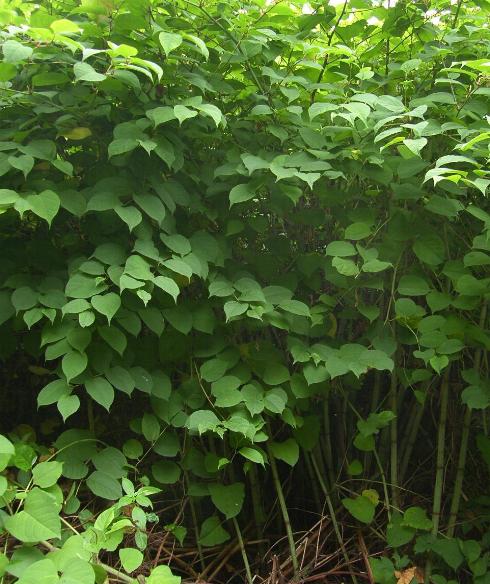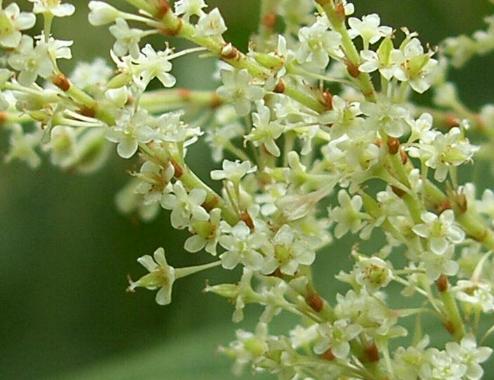Japanese KnotweedScientific Names: Polygonum japonicum, syn. P. cuspidatum, Fallopia japonica, Reynoutria japonica
|
Known as Itadori in its native Japan, it is a herbaceous perennial of the family Polygonacae - the knotweeds ("Poly " - many, "gony " - knee or joint)found on waste ground, riverbanks and on the sides of roads and railways. It is dioecious which means there are male and female flowers on separate plants. In fact the majority if not all of the plants outside their native Japan are female. So all must have been reproduced vegetatively either intentionally, when it was introduced originally in the mid-19th century as an ornamental, or accidently when it was dumped in transported soil or washed away in storms.
Long dark brown rhizomes up to 20m in length have a reddish hue when broken and are the main method by which it spreads. Nodes along the rhizome have fibrous roots and buds which produce new shoots. If chopped up, it can regenerate from as little as a 2 cm piece of rhizome in soil or in water. Small pieces of fresh stem are also able to take root so flailing and chipping can produce lots of new plants.
It prefers moist but well-drained, nutrient-rich soil, and tolerates semi-shade - but its ability to grow in a wide range of conditions, acid or alkaline and even with heavy metals present, adds to the problem. The native environment of the plant is on the slopes of volcanos and there are many species of insects and fungi which attack it and it is not so invasive; away from these there is nothing to hinder its spread and the better conditions in our gardens are ideal.
Recently a 'superweed' hybrid, Fallopia x bohemica, has become a possibility as it has been found that the female plants growing here can be pollinated by Sakhalin or Giant Knotweeed (Fallopia sachalinensis ). The warmer weather experienced now would allow the seed to germinate and grow. If the hybrid was to pollinate the female Japanese Knotweed plants the resultant plant could be capable of seeding as well as sending out long rhizomes, but fortunately F. sachalinensis is not widely grown here.
As a plant it is quite attractive with stems which are red-brown at the base and mottled green toward the tip, with bright green, heart-shaped, hairless leaves arranged alternately on the stem which zig-zags where they are present. When introduced as a garden plant, it was granted awards for being an excellent specimen, but soon lost favour when its thuggish behaviour was realised. The stems become woody as they mature, growing at a rate of 100 to 120mm (4 to 5 Inches) per day and reaching up to 3 metres (10 feet) in height. There are nodes at intervals up their length, leading to comparisons with bamboo.
Flowering occurs between July and September; small, greenish-white flowers clustered along branching panicles (similar to Russian Vine flowers), arising from the upper leaf axils. They are a good source of nectar for honeybees.
Large stands are very dense excluding all other plants, so it is a threat to native plants. The extensive underground rhizome system can be to a depth of 3m, giving it great resistance to eradication. It is capable of spreading to an area the size of a tennis court in one year and the underground parts may be extending up to 7 metres beyond edges of the topgrowth - so any soil within this area could contain rhizomes and should not be spread elsewhere or taken off site. Estimates put the cost of removal at about £9 per square metre, including herbicides and landscaping, this can cause a decrease in the value of infested land. It is estimated that about £1.6 billion is spent annually in the UK on removing it. The site of the 2012 Olympics in London had quite a large infestation which had to be cleared along with many other contamination problems before construction began - at an estimated cost of £70 million.
It is very aggressive damaging paving and tarmac as it spreads - on one occasion it found its way into a livingroom, coming up through the floorboards. A homeowner in Hertfordshire found that the value of their recently built home had dropped from £300,000 to £50,000 and that it would need to be demolished to eradicate the Knotweed that had invaded the walls and foundations. It can be a dealbreaker during the selling process even if it is in adjoining property and some mortgage providers refuse to lend on properties where it is present. The Royal Institute of Chartered Surveyors (RICS)issued guidelines some years ago that required surveyors to notify mortgage lenders if it is within 7 metres of a house and this could reduce the value by about 15%. The Property Information Form in the pre-contract enquiries which is legally binding, now contains a question specifically asking about it.
Researchers at Leeds University have suggested that the effect of Japanese Knotweed is not as much as is perceived and it may more comparable to Buddleja davidii in the threat to property. The RICS has revised the guidelines and reduced the proximity to buildings to 3 meters. Also surveyors can use their discretin when assessing the impact it may be having on the property and that it should be controlled rather than eracicated. Mortgage lenders have become more lenient and access individual cases considering specialist reports with a professional eradication programme in place before funds are released.
There are some redeeming qualities. The young, Spring shoots can be cooked and eaten, after peeling to reveal the white core. They have a mild rhubarb flavour, due to the presence of oxalic acid (hence some of the common names). Medicinally, is is a commercial source of the antioxidant Resveratrol which has been shown to extend the lifespan of some non-mammalian experimental animals and is sold as a supplement. The roots contain emodin which
has a mild laxative effect and it is part of traditional Chinese and Japanese herbal medicines for this effect. Other uses are as a diruetic, and it can be applied externally to sooth burns and skin lesions.
The roots will produce a yellow dye and there is a possibility that ithe abundant dry stems could be used as a source of biomass for conversion to fuel, which would be carbon neutral.
Some progress has been made in isolating some of the natural controlling pests and diseases in its native environment where it is usual to find lots of damage to the foliage, stems and roots inflicted by invertebrates. There are over 180 species of plant-eating invertebrates which feed on it and about 40 fungi. Of these, two insects have been isolated which have so far shown no interest in other plants which grow here, a weevil which damages the stems and a 2mm psyllid or plant louse (Aphalara itadori), which sucks the sap, thus weakening the plant. A fungus (Mycosphaerella sp.) which causes leafspot is another possiblity. After thorough testing to ensure that they will attack only the Knotweed, they may be released here as a biological control. This will not kill it outright, but the damaged plants will not grow so big and spread so fast - native flora may have a better chance to compete and keep it in check or overwhelm it completely.
CABI (Centre for Agricultural Bioscience International), the organization carrying out the research, is now confident that the psyllid is safe enough and DEFRA (Department of the Environment, Farming and Rural Affairs) granted approval for some of the psyllids, or "jumping plant lice", to be released in one area on 9th March 2010.



